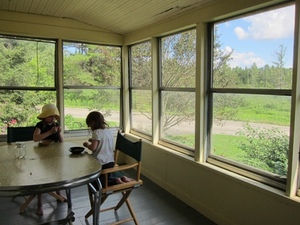Mood Resolution
/A few weeks ago I attended a workshop on conflict resolution. The goal of the session was to introduce parents to a structured format of working through conflict in a non-judgmental, non-punitive way. I admit I didn’t really want to attend, having been through several of these types of trainings over the years and not really feeling like I had the energy to tape mock identities to my forehead for role-plays about bullies and nerds. But I felt pressure to attend from the mass of flyer and email announcements, and the buzz about it from other parents sparked a sliver of hope that this workshop would offer something fresh and new. Plus, with free childcare, I really didn’t have any excuse. But as I sat down in the circle of other parents, I couldn’t help but regret having given up what could have been an afternoon to myself.
I participated in the workshop nonetheless. There were no bully-nerd role-plays; instead we provided examples of conflicts we’d recently experienced to work through in small groups. The time our neighbors wouldn’t turn down their music. Then we identified our emotions with “feeling cards”, angry, frustrated, disappointed, and linked them to our needs that weren’t met, support, shared reality, understanding. We provided feedback to each other on how to word an offense in a neutral, non-accusatory way. When the music is loud, I feel frustrated because my children can’t sleep. I played along half-heartedly while the parents around me appeared enlightened by the concept of identifying the true source of the conflict.
After the workshop, a friend asked if I had enjoyed it. I shrugged and mentioned it wasn’t really new information, and made some vague comment about having heard all of this before. She nodded and said, “Well, it’s always good to hear it again”. This friend obviously had a good attitude. I, obviously, did not, and at home, I complained to my husband that I didn’t get anything out of the workshop.
But of course that wasn’t actually true. Over the past few weeks, snippets from the workshop have snuck into my mind, not in moments of conflict, but in moments of general dissatisfaction. Like on those days when my late afternoon plan unravels in the face of tantrums and bickering, and my cup of tea, already twice reheated, sits un-sipped on the counter. The snippet hints, as if mocking me, Hmm, it looks like you are frustrated that you don’t even get ten minutes of uninterrupted time for a cup of tea... Or when my irritation suddenly spikes for no good reason, say, at the sight of the pile of crap that’s been sitting on the table for a week. The snippet taunts, Gee, I wonder what need isn’t being met; longing for a tidy and organized space, are you? At first I ignored the snippets, grumpily giving up on my tea and cursing the pile of crap on the table. But in the background, I’ve started to realize this annoying little voice in my head might actually carry some wisdom. Maybe the workshop wasn’t just about identifying emotions and needs during my children’s conflicts. Maybe I could use the information to work on bettering my mood. Mood resolution.
It’s pretty easy to identify frustration and impatience as the core “bad mood” mom emotions, and I can easily rattle off a whole list of unmet needs, as could any other mom, with lack of sleep at the top. But when I push past the superficial needs (I mean, everyone - kids or no kids - could probably claim sleep as an unmet need), the one thing I cherish but never, ever get anymore is time alone at home. I can add up an hour’s worth of time to myself if I count the six-mile drive to school for drop-off and pick-up and the occasional twenty-minute walk at lunch. But those moments borrowed against the usual routine are nothing compared to the liberation of being alone in an empty house for a good, long stretch of time. Time to wander through the rooms in their quiet stillness. Time to put things where they belong without little hands taking out other things à la Sisyphus. Time to not be needed by anyone.
Hey, look at that, the snippet applauds, you’ve identified the unmet need that is the source of your poor mood! Enlightening.
Of course I don’t see any way to meet this need for at least the next two years, and the workshop, unfortunately, didn’t cover how to deal with unmeet-able needs. But maybe simple awareness is a good start. It’s already easier to curb my frustration when I admit the mess itself isn’t really the issue, and that in a few years I will get to sip my tea while it’s still hot.











































